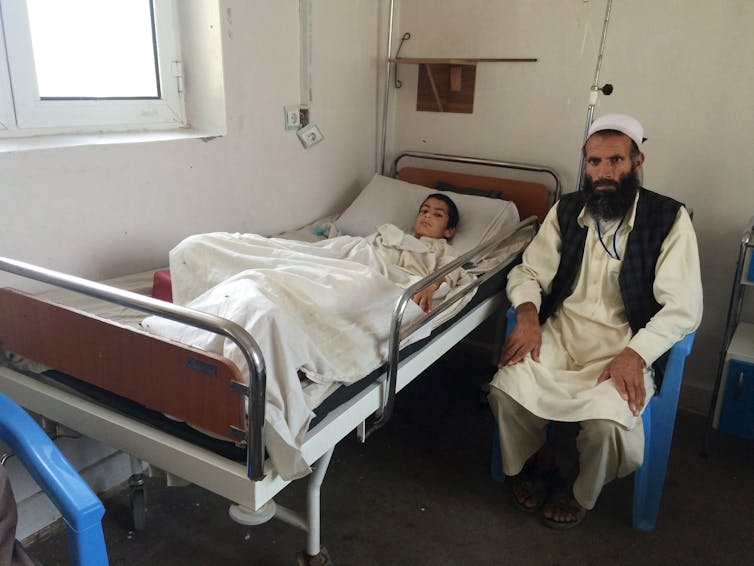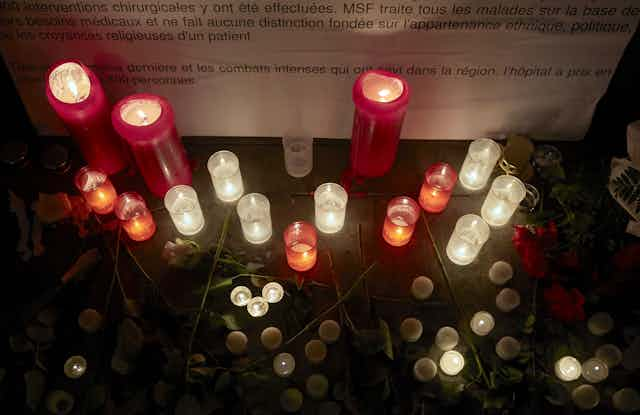A hospital bombed in the midst of intense fighting. Patients and staff killed and wounded, the facility destroyed. An unspeakable tragedy – and unfortunately one seen before in recent and current conflicts.
The US airstrike that hit the Medecins Sans Frontières (MSF) hospital in Kunduz, Afghanistan on Saturday was a horrible tragedy. But was it a war crime, as the organization immediately asserted?
Bombing a hospital and killing doctors and wounded or sick persons may seem, on first glance, to be an obvious war crime. If it isn’t, one might wonder, what is? MSF’s outrage is understandable and genuine.
However, the reality of both the law and the facts is significantly more complicated. This incident highlights not only the challenges and tragic consequences of war in populated areas, but also the dynamic interplay between media coverage of military operations and the legal regulation of armed conflict.
The law of war
The law of war – also called international humanitarian law or the law of armed conflict – governs the conduct of states, armed groups and individuals during armed conflict and seeks to minimize harm to civilians as much as possible.
War crimes are serious violations of the law of war. They include unlawful attacks on civilians and attacks on protected objects such as hospitals and religious or cultural property. Not all attacks that result in civilians dying or hospitals destroyed are automatically war crimes, however. The lawfulness of any attack will depend on both the intended target of the attack and the method of carrying it out.
So what do we know – or at least potentially know – right now about the incident in Kunduz?
The Kunduz case
News reports state that the US airstrikes were in response to requests from Afghan forces under fire from Taliban insurgents. They were aimed at those Taliban fighters, with several strikes mistakenly hitting the hospital in the course of those attacks.
Other reports from Afghan sources asserted that the Taliban was using the hospital grounds to plot and launch attacks, including “firing rocket-propelled grenades from the property,” and the airstrikes were aimed at the perimeter of the hospital property to stop the attacks.
The hospital building suffered several direct hits. Twenty-two people were killed and many more injured.
Key issues
The first question is whether the intended target of the airstrikes was a lawful target.
The law of war authorizes attacks against enemy soldiers, members of armed groups, civilians directly participating in hostilities and military objectives. Deliberate attacks on civilians or civilian objects (such as schools or residential buildings) are prohibited.

Hospitals enjoy special protection under the law of war and are immune from attack. Using a hospital for military activities, personnel or equipment is prohibited. However, when a hospital is used for military purposes, it loses its protection from attack and can become a lawful military objective.
As fighters in the enemy armed group, the Taliban insurgents were legitimate targets. If the Taliban were using the MSF hospital to launch attacks, then the Taliban violated the law of war by using medical facilities to shield military objectives, namely their personnel and their rocket-launchers. In addition, the hospital would have lost its protection from attack after due warning to cease the military activity, becoming a legitimate target for attack.
If, as reports suggest, the airstrikes were aimed at Taliban fighters near the hospital or Taliban fighters and equipment using hospital property and facilities to shield their activities, then the choice of these targets would not run afoul of the law.
But that is not the end of the story.
The law does not focus only on the target of the attack, because prohibiting direct attacks against civilians and civilian objects can only go so far in protecting civilians. The law also mandates extensive steps to protect civilians and civilian objects from incidental harm during lawful military operations.
The two most important are precautions and proportionality.
The principle of precautions mandates additional steps to minimize harm to civilians from attacks. An attacking party must verify that the target is a lawful military objective, use weapons that will minimize incidental harm to civilians, avoid indiscriminate or disproportionate attacks and provide effective advance warning where feasible.
The principle of proportionality requires that an attacker refrain from any attack in which the expected civilian casualties will be excessive in light of the anticipated military gain from the attack. That is, an attack expected to cause excessive collateral damage is unlawful.
Proportionality is at once both simple and highly complex.
It is simple because the idea of maximizing protection of civilians by minimizing incidental harm from military operations is straightforward and sensible. It is complex, however, because it demands that one understand the military advantage of a particular attack, assess the likely expected civilian casualties and determine whether those casualties will be excessive in the circumstances at the time of the attack.
Outstanding questions
The airstrikes in Kunduz raise significant questions about precautions:
- Did the Afghan forces calling for the strike and the US forces launching the strike establish the location of the hospital as a protected site?
- Were the Taliban fighters indeed using the hospital?
- If so, did either Afghan or US forces warn the hospital of the pending strike?
- Were weapons chosen that could minimize harm to civilians?
The proportionality rule poses equally important questions:
- What did the US forces know about the hospital and how many people were in it?
- What damage to the hospital did they anticipate from the attacks?
- What other options did they have to neutralize the Taliban threat?
In the end, only a comprehensive investigation – like those under way by the US, NATO and Afghanistan – can determine the cause and legality of the strike by examining these and other questions.
Most important, however, any legal analysis must examine these questions prospectively; that is, from the perspective of the US forces and what they knew at the time of the attack – not from the perspective of the hospital staff or from the retrospective view of the horrified observer or readers of the news after the fact.
Here lies perhaps the biggest challenge in the aftermath of a horrible tragedy: the suffering and horror are all too evident immediately after the incident, but the legality or illegality of an attack rests on the information available to the commander at the time, and the intent and reasonable judgment of the commander in launching that attack.
Real-time media coverage can do justice – in a sense – to the tragedy and suffering, but not to the question of legality without the information essential to and uncovered in the course of a thorough investigation.

